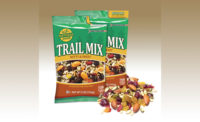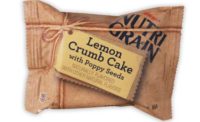Advances in packaging materials continue to extend shelf life, while adding convenience and freshness to bakery and snack goods. Innovations in modified-atmosphere packaging (MAP), microbial-inhibiting film, and the use of cellulose nanocrystals are helping to push the envelope. The challenge is how to make these materials more recyclable and eco-friendly.
Continued increase in the use of bags and pouches for baked goods is on the horizon, according to the latest “Flexible Packaging Assessment Report” issued by PMMI, Herndon, VA. The primary drivers for this trend are the lower cost of the packaging format, the ability to see more of the product, and the excellent freshness protection.
“Snack foods will see an increased use of pillow pouches due to the expansion of single-serve offerings for portion control and convenience. Snacks that require smaller pouches for nuts and dried fruit, nutrition bars, and mix-in protein powders facilitate the healthy eating trend and stand to support growth through 2022,” says Sean Riley, senior director, media and industry communications, PMMI.
Millennial buying power fits this trend. Millennials are looking for re-sealable, reusable, and recyclable packaging options. That gives brand owners and converters new opportunities to develop their packaging with circularity in mind. Another trend is that more consumers are snacking on-the-go and prefer easy-open and resealable packaging.
Shorr Packaging Corp., Aurora, IL, continues to look to Europe, the Middle East, and Asia for new, cutting-edge materials that maximize shelf life, aesthetics and performance, according to Ken Nakashima, director, food packaging. “Various paper substrates continue to be the leading material of choice in the bakery segment for the majority of companies striving for sustainability and to meet corporate initiatives.”
Industry trends
Amcor Flexibles Americas, Buffalo Grove, IL, has seen the elimination of PVDC as a barrier component of film in the bakery and snack market, according to Chris Borgardt, associate marketing manager–bakery. Shifts to ethylene-vinyl alcohol copolymer (EVOH) barriers in polyethylene have streamlined the value chain. “We have seen a shift in the bread bag market from polyethylene to polypropylene—some bags pure polypropylene, others a blend. These bags give a clearer appearance, a more robust structure and substantially more stiffness.”
The need for sustainable packaging is increasing in a bakery and snack market that mainly uses multi-component packaging, Borgardt adds. “Polyester-polyethylene laminations are a staple in this market, but do not allow for recyclability. We’ve seen a rapid shift to one-stream packaging through the use of machine direction polyethylene; these PE-PE structures allow for recyclability. However, the material is in its early stages and carries a high cost of production.”
Riley notes a lack of recycling options for multi-material laminated films, such as snack bags and foil pouches, which are difficult to separate into various material substrates. “Although packaging material vendors across the globe are scrambling to develop sustainable materials to reduce environmental impact, it is a time-consuming and expensive process. Bakery and snack companies need to build flexibility into their supply chains.”
Andrew Manly, communications director, The Active & Intelligent Packaging Industry Association (AIPIA), Utrecht, the Netherlands, says the EU-funded NanoPack project, which aims to develop a microbial-inhibiting film for commercial development, concluded at the end of 2019. “The flexible packaging material created showed some remarkable results in inhibiting microbial and fungal growth of bread and baked products. But the work continues.”
While the focus of many packaging material suppliers and users was on sustainability, this did not stop the steady growth of smart packaging applications in 2019 and early 2020 as the demand for authentication and security increased, Manly adds. Of course, the arrival of the COVID-19 pandemic disrupted many projects.
“Projects such as PRISM are using smart packaging ideas to help identify and sort plastics for recycling, while advances in digital printing and ink-jet codes mean they are much more ubiquitous, offering big opportunities to adopt security and consumer engagement features,” says Manly. “These codes can be added to almost any packaging substrate, both rigid and flexible.”
PRISM (plastic packaging recycling using intelligent separation technologies) is a new way to sort packaging for recycling. The process uses smart labels that have invisible markers, which can be detected and sorted using existing optical sorting systems. The PRISM project is led by plastics recycling consultancy Nextek, with a number of development partners in place. The technology is seen as an efficient way to sort materials such as polypropylene food packaging.
The green initiative
Dow Packaging and Specialty Plastics, Midland, MI, continues its quest to develop sustainable packaging. According to a recent agreement, Avangard Innovative LP (AI), Houston, will supply post-consumer resin (PCR) plastic film pellets to Dow. The companies will begin offering Dow’s first-ever PCR-based packaging material later this year to companies that are demanding more sustainability in applications such as liners, shrink-wrap, and protective packaging. Dow will initially use the PCR from AI to create linear, low-density polyethylene products.
“We’re giving our customers the tools they need to supply consumers with products made from recycled plastic, like the liners they place in their waste bins and the shrink wrap they use to bundle and ship packaged goods,” says Victor Zapata, recycling commercial director, Latin America and North America, Dow.
In another sustainability initiative, researchers at Purdue University, West Lafayette, IN, have created a manufacturing process using cellulose nanocrystals (CNCs) as advanced barrier coatings for food packaging. CNCs, a renewable raw material, offer non-toxicity, biodegradability, high specific strength, high thermal conductivity, and optical transparency. The technique is scalable because it is a roll-to-roll manufacturing process that uses waterborne polymer systems.
The Purdue team is led by Jeffrey Youngblood, a professor in the School of Materials Engineering. He is uncertain when the process will be available for use by the packaging industry. “The formulation has a way to go, but we have not done any work on scale up. While we can do 50 meters of 4-inch trim-width on our small roll-to-roll machine, this is a far cry from the size and production rates necessary for industrial use. Piloting the process will be crucial.”
As for further advances down the road, Youngblood says his team is still screening formulations to achieve optimal properties. So far, they have achieved impressive moisture vapor transmission rates. “Oxygen transmission rates are still not where we want them, but they’re improving. We’ve moved slowly as we’ve constrained ourselves to food-approved materials in the formulation, but I’m sure we will get there before too long.”
More options
Digimarc Corp., Beaverton, OR, offers an alternative packaging material solution. The Digimarc Barcode can replace traditional UPC/EAN barcodes and two-dimensional alternatives such as DataMatrix and QR codes, which are highly visible and require dedicated design space, limiting their use to just one instance per package. “By comparison, the low contrast of the Digimarc Barcode makes it imperceptible to consumers. This allows for repeating the code many times across a package,” says Scott Wilcox, vice president, client services.
The Digimarc Barcode makes use of more of the package or label, even when the material is damaged, curved, multi-sided, or distorted. “Digimarc supports the batch-, lot-, and item-level traceability required of complex supply chains, by applying serialized or custom identifiers to product packaging with variable data printing,” Wilcox adds.
On the equipment side, Harpak-ULMA Packaging LLC, Taunton, MA, offers the Mondini Platformer thermoformer, which allows snack-style trays (as well as other types) to be formed with 2 percent scrap material. “This low waste combined with the eco-friendly benefits of trucking rollstock versus preformed trays makes the Platformer a great option for sustainability. It also allows processors to produce packages at a fraction of the cost incurred through standard methods,” says Carlo Bergonzi, assistant product manager, tray seal.
Looking ahead, Manly says the COVID-19 pandemic has heightened interest in food safety and security—and perhaps made consumers realize that food packaging is not just there to make their shopping easy and convenient. With greater awareness of hygiene, traceability, and food safety, there is a real opportunity for smart packaging technologies to show their benefits and gain wider traction. “Trust in ‘best before’ and ‘use by’ dates is eroding. But condition monitors and visual warning features about the real condition of packaged food can renew consumer confidence in this area.”







